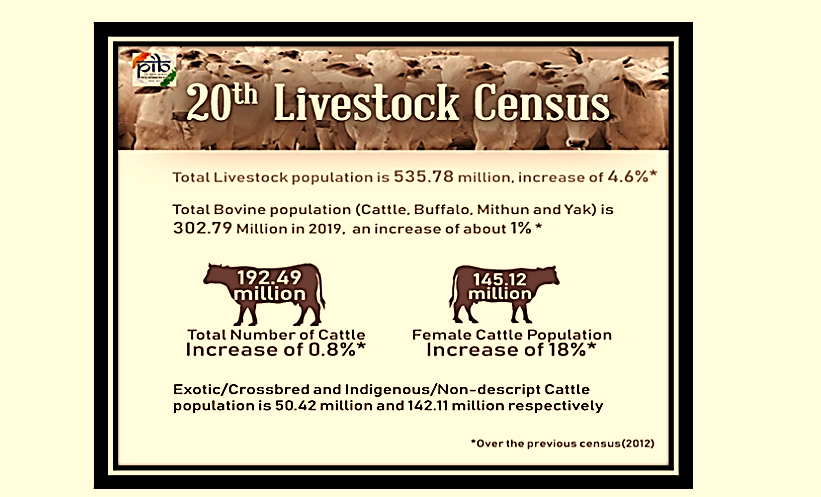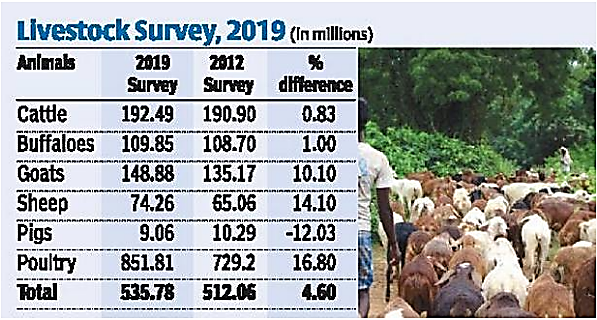20th Livestock Census Released
- 18 Oct 2019
- Recently, the Department of Animal Husbandry & Dairying, Ministry of Fisheries, Animal Husbandry and Dairying released the 20th Livestock Census report.
- It was carried out in about 6.6 lakhs villages and 89 thousand urban wards across the country covering more than 27 Crores of Households and NonHouseholds
Background
- The Livestock Census has been conducted in the country periodically since 1919-20.
- So far 19 such censuses have been conducted in participation with State Governments and UT Administrations.
- The 20th Livestock Census was launched in October, 2018. The enumeration was done in both rural and urban areas.
- For the first time, livestock data were collected on line in 20th Livestock Census.
- Another important feature of 20th Livestock Census is it has been designed to capture Breed-wise number of animals and poultry birds.
- The breeds of various major species including Poultry as registered by National Bureau of Animal Genetic Resources(NBAGR) will be covered in the Livestock Census.
Key Outcomes
- The total Livestock population is 78 million in the country showing an increase of 4.6% over Livestock Census-2012.
- Total Bovine population (Cattle, Buffalo, Mithun and Yak) is 302.79 Million in 2019 which shows an increase of about 1% over the previous census.
- The total number of cattle in the country in 2019 is 192.49 million showing an increase of 0.8 % over previous Census.
- However, the number of indigenous cattle has gone down from 2012 to 2019. The number of milch animals has gone up by 6 percent.
- The total buffaloes in the country is 109.85 million showing an increase of about 1.0% over previous Census.
- The total sheep in the country is 74.26 million in 2019, increased by 14.1% over previous Census.
- The Goat population in the country in 2019 is 148.88 million showing an increase of 10.1% over the previous census.
- It shows a sharp increase in backyard poultry.
- Among the States, Uttar Pradesh has the highest number of livestock of 67.8 million (68.7 million in 2012), followed by Rajasthan 8 million (57.7 million), Madhya Pradesh: 40.6 million (36.3 million) and West Bengal: 37.4 million (30.3 million).
- Unfortunately, in Uttar Pradesh, the number of cattle is down from 19.6 million in 2012 to 18.8 million (down 3.93 percent).
- Apart from Uttar Pradesh, the cattle count is down in Madhya Pradesh (by 4.42 percent), Maharashtra (10.07 percent) and Odisha (01 percent ).
- West Bengal has seen a rise in cattle population by 15.18 per cent, Bihar by 25.18 per cent, and Jharkhand by 28.16 per cent between 2012 and 2019.
 Source:PIB
Source:PIB
 Source: BusinessLine
Source: BusinessLine
Government Schemes for LivestocksRashtriya Kamdhenu Aayog (RKA)
|
Significance of Report
Help in Conservation of Indigenous Breed:
- The initiatives on collection of breed-wise reliable information of various species will give vital information for determination of threatened indigenous breeds and to take initiatives accordingly for their conservation.
- It will be helpful for framing policies or programmes for Breed improvement.Breed-wise information of livestock and poultry.
Fulfiling Digital India Objective:
- The major thrust of 20th Livestock Census would be data collection through tablets computers which is aimed to fulfil the objective of Digital India Programme.
Wide Range of Beneficiaries:
- The Census will prove beneficial not just for policy makers but also for agriculturists, traders, entrepreneurs, dairying industry and masses in general.
Way Forward
- Indian livestock sector makes up for a significant amount of world's livestock resources. Both the national economy as well as the socio-economic growth of the country is backed by the livestock sector. Besides, offering great potential and outstanding contribution in the agricultural sector over the past years.
- Rapid growth and transformation in the livestock sector offer both challenges and opportunities for smallholders and require a difficult balancing act by policy-makers.
- Growth in the livestock sector offers significant opportunities to enhance food security and reduce poverty, but concerted gender-sensitive action is required to help those smallholders who can compete to take advantage of the emerging opportunities.
- A mix of policy change, technological and institutional innovation and investment is needed. Building locally specific capacity that can respond to change is especially important.
- Propelling livestock production into 'mission mode' is one of the keys for the present government as it will help in achieving the ambitious target of making India a $5 trillion economy by 2024.


